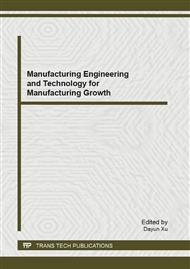[1]
S. Mitsumori, Optimal schedule control of conveyor line, IEEE Transactions on Automatic Control. 10 (1969) 633–639.
DOI: 10.1109/tac.1969.1099300
Google Scholar
[2]
J. Gottlieb, M. Puchta, C. Solnon, A study of greedy, local search and ant colony optimization approaches for car sequencing problems, Lecture Notes in Computer Science, Springer, Berlin. (2003).
DOI: 10.1007/3-540-36605-9_23
Google Scholar
[3]
J. Miltenburg, Level schedules for mixed-model assembly lines in just-in-time production systems, Management Science. 35 (1989) 192–207.
DOI: 10.1287/mnsc.35.2.192
Google Scholar
[4]
N. Boysen, M. Fliedner and A. Scholl, The product rate variation problem and its relevance in real world mixed-model assembly lines, European Journal of Operational Research. 197(2) (2009) 818-824.
DOI: 10.1016/j.ejor.2008.06.038
Google Scholar
[5]
C. J. Hyun, Y. Kim, and Y. K. Kim, A genetic algorithm for multiple objective sequencing problems in mixed model assembly lines, Computers & Operations Research. 25(7-8) (1998) 675–690.
DOI: 10.1016/s0305-0548(98)00026-4
Google Scholar
[6]
P.R. McMullen, An JIT sequencing for mixed-model assembly lines with setups using tabu search production, Planning & Control. 9(3) (1998) 504-54.
DOI: 10.1080/095372898233984
Google Scholar
[7]
P.R. McMullen, Frazier, G.V., A simulated annealing approach to mixed-model sequencing with multiple objective on a JIT line, IIE Transactions. 32(8) (2000) 679-686.
DOI: 10.1080/07408170008967426
Google Scholar
[8]
P.R. McMullen, An efficient frontier approach to addressing JIT sequencing problem with setups via search heuristics, Computer & Industrial Engineering. 41 (2001a) 335-353.
DOI: 10.1016/s0360-8352(01)00059-6
Google Scholar
[9]
P.R. McMullen, A Kohonen self-organizing map approach to addressing a multiple objective, mixed-model JIT sequencing problem, International Journal of Producntion Economics. 72 (2001b) 59-71.
DOI: 10.1016/s0925-5273(00)00091-8
Google Scholar
[10]
P.R. McMullen, An ant colony optimization approach to addressing a JIT sequencing problem with multiple objectives, Artificial Intelligence in Engineering. 15 (2001c) 309-317.
DOI: 10.1016/s0954-1810(01)00004-8
Google Scholar
[11]
R. Tavakkoli-Moghaddam, A.R. Rahimi-Vahed, Multi-criteria sequencing problem for a mixed-model assembly line in a JIT production system, Applied Mathematics and Computation. 181(2) (2006) 1471-1471.
DOI: 10.1016/j.amc.2006.02.033
Google Scholar
[12]
A.R. Rahimi-Vahed, et al., A multi-objective scatter search for a mixed-model assembly line sequencing problem, Advanced Engineering Informatics. 21(1) (2007) 85-99.
DOI: 10.1016/j.aei.2006.09.007
Google Scholar
[13]
Wenhui Fan, et al., Balancing and simulating of assembly line with overlapped and stopped operation, Simulation Modeling Practice and Theory. 18 (2010) 1069-1079.
DOI: 10.1016/j.simpat.2009.11.008
Google Scholar
[14]
SisiXuanyuan, Zhaoliang Jiang, LalitPatil, Yan Li, Zhaoqian Li. Multi-Objective Optimization of Product Configuration. Proceedings of ASME International Design Engineering Technical Conferences and Computers and Information in Engineering Conference, New York, USA: ASME. (2008).
Google Scholar


